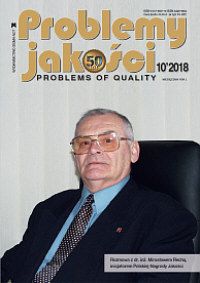
- Polish quality in the 100 anniversary of independence
"TQM is a type of collective effort oriented towards quality and leading to continuous improvement of the organization in order to achieve the highest results in all decisions and forms of activity." Professor Edward Kindlarski, one of the classics of the Polish school of quality. Tradition that shapes the future of the 100th anniversary of independence, celebrated in our country in 2018, as well as the 25th anniversary of the Polish Quality Award, falling in 2019, and the 100th anniversary of the birth of scientific management through quality, originating in the years of the last century, provide an opportunity to share a reflection on the shaping and credibility of quality. The Polish Quality Award is the formula adopted in the mid-1990s to identify the best - ensuring not only the required but also expected quality by the market - organizations aiming for excellence, as well as people actively co-creating and implementing quality ideas into life. In November this year. the organization of the national conference dedicated to the Polish Quality Award - "Polish Quality in the 100th Anniversary of Independence" - is planned. This conference is to be a forum for discussion on important and current issues regarding the role of innovation in the Polish economy, the existence of quality in the minds of Poles and quality as determinants of excellence.
- Risk management maturity assessment models
Risk management is currently considered as one of the key management domains, often determining not only the survival and development of the organization in a turbulent environment, but also achieving a competitive advantage. To shape effective risk management systems, a continuous assessment is necessary to identify areas for improvement and outlining the path of their continuous improvement. Such assessment is made possible by models of risk management maturity, which primarily diagnose the level of advancement of activities carried out in this area, and also indicate the target standard status. These models refer to integrated risk management in an organization or to activities in relation to risk in specific functional areas, eg in project management. The aim of this text is to characterize and compare selected models of risk management maturity assessment, taking into account their specificity, degree of complexity and universality.
- Evaluation of the implementation of the quality management system for compliance with the PN-EN ISO 9001: 2015 standard in the light of the results of external audits
In the light of increasing customer requirements and continuous economic progress, quality has become the main direction of building a competitive advantage of the organization, regardless of the market in which it operates. Quality management, as one of the management processes, can be supported by available tools that ensure effective implementation of quality standards. One of the most popular tools is the use of ISO 9001 in practice in quality management. Standards, like legal provisions, are periodically updated due to changes in the external environment, entrepreneurs' experience in their implementation and recommendations of auditors of certification bodies.
- From the foreign press
Criteria for choosing a certification body. Often, when we talk about a quality management system (QMS) compliant with the requirements of the ISO 9001 standard, it is stated that it has been implemented and certified. These two concepts are mentioned together as if they were inseparably connected with each other. In fact, an organization that has implemented the QMS may or may not undergo certification. It should be remembered that certification involves the need to incur additional costs and organizational effort.
- Continuous improvement of quality. When ISO 9001: 2015 is no longer enough
The current economic conditions of functioning in a hyper-competitive global reality force organizations to look for attractive niches or acquire unique competences. Over the past four decades, one of the foundations of building a competitive advantage has been the implementation of quality management systems compliant first with the BS 5750 standard, then with the ISO 9 001 standard. When ISO 9001: 2015, it is no longer enough to allocate resources and identify key actions leading to the improvement of significant business indicators and the implementation of continuous improvement tools. With time, however, as these systems become more popular, the clear positive effects of their implementation cease to be so clear. There are even voices that implementation of management systems compliant with the ISO 9001 standard does not bring any effects. From a business point of view, the phenomenon where, as more specific solutions become popular, the effects of their implementation in individual units are not as pronounced as in the case of pioneers, and with time even completely imperceptible, it is normal. One should then look for another foundation of building a competitive advantage, which will help both to improve management and to guarantee the desired economic efficiency. This is often related to the organization's search for a new niche and entry into it.
Problemy Jakości (Quality Problems) - full list







